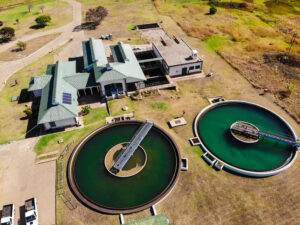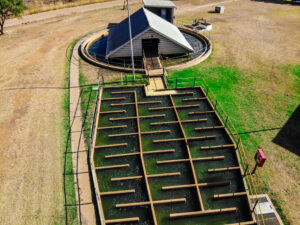As the North-West province’s sole water board, Magalies Water is relentless in its endeavour to supply quality bulk water to the area. Kirsten Kelly talks to Maipato Thoola (MT) – a water quality process specialist at Magalies Water – about proactively ensuring drinking water safety.
Magalies Water consistently supplies its customers with potable water that complies with the SANS 241 requirements. What kind of challenges do you experience when it comes to maintaining these high levels of water quality? MT: Our biggest challenge is deteriorating raw water quality due to upstream activities. According to the Green Drop Report, a significantly high number of municipal wastewater systems are now rated as critical, meaning that many of our rivers and dams are overloaded with partially treated wastewater which results in high amount of microbial contamination, organic matter, and emerging contaminants. Furthermore, climate change influences the presence, concentration, transformation, and impacts of upstream activities to downstream water users. Higher water temperatures can accelerate chemical reactions, potentially increasing the transformation of some contaminants and secondary pollutants into more harmful byproducts. Most recently, water quality issues in the Taung and Rustenburg areas have been highlighted. What is happening there? We have been receiving poor raw water quality. This has been noted by the increase in the treatability index, which is confirmed by concentration of contaminants such as high concentration levels of manganese in our water treatment systems. We are currently blending the raw water from the dams with canal supply which has better quality and we have implemented optimised dosages for pre-chlorine, lime. Furthermore, we have introduced advanced technologies such as chlorine dioxide. In general, what is Magalies Water doing to cope with deteriorating raw water quality?

Cullinan Water Treatment Plant
We have firstly increased our monitoring frequencies and there is more onsite monitoring, which enables prompt response times. Magalies Water also participates in catchment forums for stakeholder information sharing to deal with water quality deviations before that water leaves our treatment plants. We have also invested in advanced treatment technologies. To combat the high levels of organics coming into our water treatment plant, we have initiated the use of ozone for oxidation, which works particularly well for emerging contaminants of concern like Geosmin and 2MIB. At some sites we have introduced chlorine dioxide as an alternative oxidant. Our water treatment processes have been designed to ensure that there are sufficient residual disinfectants in the bulk distribution network to keep the water sterile and safe from microbial contaminants. What is your capacity regarding water testing? Scientific Services houses the Laboratories, Research and Water Quality Process Office. Here, water quality and process specialists focus on SANS 241 compliance, process audits and management of the Department of Water Affrairs’ IRIS system in a drive to attain Blue and Green Drop status.

We have a SANAS (ISO 17025:2015) accredited laboratory with state-of-the-art equipment such as:
- ICP-OES – Inductively coupled plasma/optical emission spectrometry is a well-established and powerful technique for the analysis and quantification of metals in high concentrations.
- ICP-MS – Inductively coupled plasma/mass spectrometry that measures an atom’s mass and analyses trace metals.
- GS-MS – Gas chromatography/mass spectrometry (GC/MS) combines two analytical tools to identify and measure the concentration of organics, particularly contaminants like Geosmin and 2MIB.
- A specialized microscope with inverted light.
- PCR instrument for DNA testing
This enables us to offer an all-inclusive suite of services to test water samples for an extensive set of quality parameters, such as viruses, minerals, chemicals, bacteria and organic materials. The laboratory serves as a buffer to make sure that the water reaching the consumers is safe to drink, or suitable for domestic use. There is a specific section in the laboratory for quality assurance that verifies existing quality results. There is also a research and development section where all potential risks within our water system are identified for the development of water safety plans. Due to its equipment and skilled workforce (including qualified chemists, microbiologists and water-treatment technologists), the laboratory is also used commercially and offers the water industry a wide variety of services in the fields of chemical and microbiological analyses, as well as expert advice on water-related problems. Your origins began with exclusively supplying mining houses in the platinum belt region of Rustenburg and Thabazimbi. What is your relationship like with the mining sector now? We work very closely with our mining houses. We have established a Mining Forum whereby we meet bimonthly to share water quality results and share ideas around challenges with water supply and quality as well as any progress we have made in mitigating challenges. They are quite helpful and a recent example is where we were unable to access the sample point due to the damaged road. The mining houses quick to response by providing access to their premises for sample collection. How did Magalies Water perform in the recent Blue Drop audit? The Blue Drop audit was conducted around the transition phase where Magalies Water had not fully absorbed Sedibeng Water. Therefore, Sedibeng was audited separately from Magalies Water.

Wallmansthal Water Treatment Plant
We performed well (93%) and received this comment from the auditors: “The scale of the Magalies Water system is significant, and the local municipalities are fortunate to have this utility to assist them in the provision of safe drinking water for their consumers. The water quality data shows excellent compliance to all the required parameters and consumers within the Magalies Water area of supply are assured of being able to drink water straight from the tap.” There were findings during the audit process that were mainly related to the condition assessment of the works as well as the capacity of the engineering personnel. We have moved swiftly to address those findings. We have just appointed Sibongiseni Mbadamana as the new general manager: Projects and Engineering Services. Concluding remarks When I joined Magalies Water in 2019, there were only four water treatment plants. Today there are over 20 under our control. There is a lot to be proud of; clean audits, rapid growth, development and upskilling of young people within the organisation. I am confident that the leadership in the organisation will move us to even greater heights.










